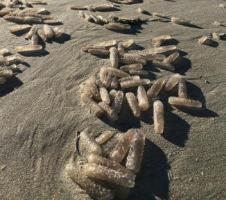
Photo: Steve Morey
The Pacific Ocean appears to under attack by a horde of sea-pickles. The bumpy, translucent, pickle-shaped organisms called pyrosomes are filling fishing nets, clogging hooks and washing up on beaches along the coast of the Pacific Northwest of the US and Canada. They are also befuddling scientists who have no idea why the population of the tube-like organisms has exploded. Pyrosomes are common in the tropics and occasionally appear in more northern Pacific waters, but no one has an explanation of why they have appeared in such large numbers as far north as Alaska.
Pyrosomes are strange creatures, to begin with. They are tunicates, colonies of individual organisms known as zooids that feed off of plankton and other small organisms. In the tropics, they can reach a length of 30 feet and often glow in the dark. The pyrosomes in the Nothern Pacific have been up to two feet long.
As reported by National Geographic:
In 2014 and 2015, when a warm water blob temporarily transformed the eastern Pacific, animals of all stripes appeared where they didn’t belong. Warm-water sharks and tunas were caught in Alaska. Tropical sea snakes appeared off California. The longest and most toxic bloom of algae ever recorded poisoned crab, anchovies, and seals and sea lions. And a handful of pyrosomes began washing ashore.
But then temperatures started to cool, and as the rest of the sea seemed to revert to normal, for some reason these creatures began to multiply. By early this spring they came to dominate much of the top several hundred feet of sea, particularly far offshore in Alaska.
“When fishermen were trolling for chinook in midwater, they were dragging these lines with 50 hooks and they were coming up with these things on basically every hook,” says Leon Shaul, with Alaska Department of Fish and Game. “It got to the point where they couldn’t effectively fish.”
Shaul says one fisherman put a few in a bucket—and eventually threw them overboard. Only later did he notice that the bucket was glowing.
“The water was really thick with them,” says Aaron Baldwin, with the Alaska Department of Fish and Game.
Then, during a research trawl just two weeks ago several hundred miles off Oregon, scientists spotted them by the tens of thousands.

last summer we were having a sea pickle problem on the S.S. Maui, from a hundred or so miles from Puget Sound, down the coast to Oakland, and then a hundred or so miles out from SF, we used the circ pump instead of the scoop, because of sea pickles, they clogged a L/O cooler twice.
I wonder as if the otters and sea lions were dying off as they were trying to feed on the pyrosomes instead of their normal meals. Granted the shelfish that Otters were eating were alo going missing.